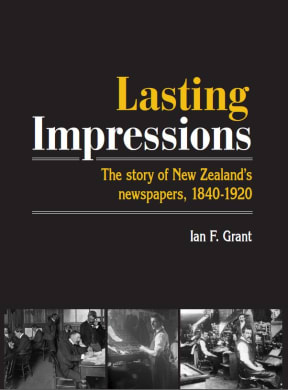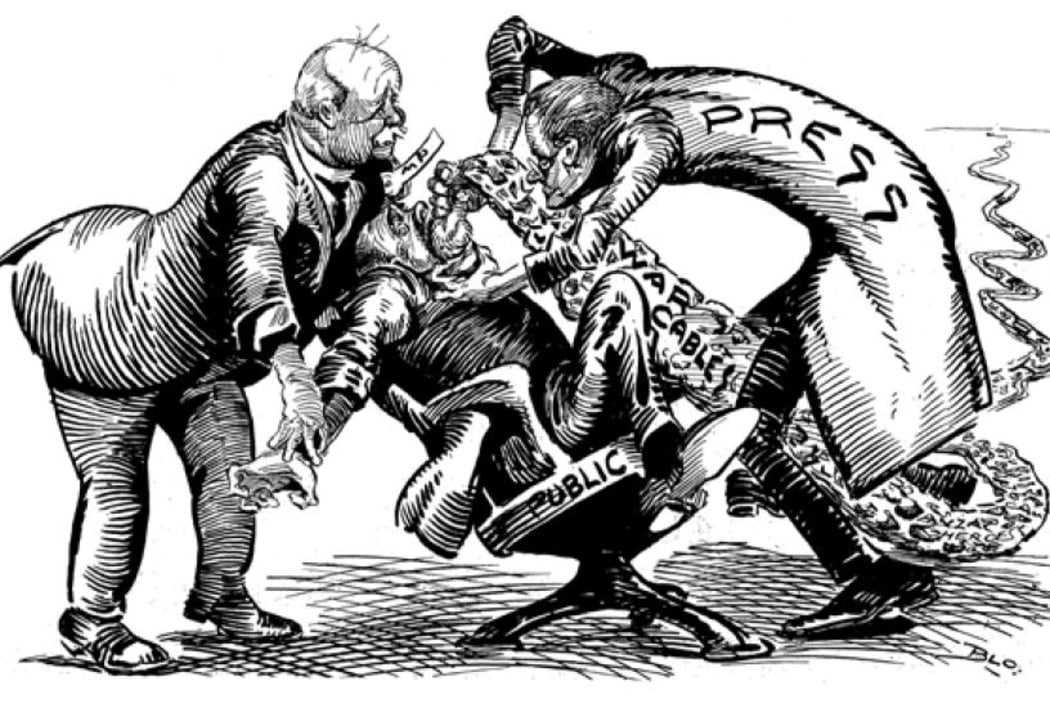The days of printed newspapers may be numbered in the digital era, but until the 1920s there were no other news media at all - and New Zealanders were eager readers. Historian and author Ian F Grant tells Mediawatch about what we can learn from the papers of a century ago.

Ian F Grant with his new book covering 80 years of new Zealand newspaper history. Photo: PHOTO / RNZ Colin Peacock
This weekend one of the country’s biggest selling papers cut itself down to size.
The Sunday Star Times is now tabloid-sized - or ‘compact’ as the publisher prefers to put it.
Its stablemate Sunday News has been a tabloid for decades and earlier this year, the daily papers in Stuff’s stable also shrank to the size it says readers now prefer, according to their market research.
In a piece prepping its readers for the change, the paper reassured readers that “journalists, columnists and photographers from Whangarei to Invercargill will still be putting together a quality paper.”
Online, editor Jonathan Milne reinforced the message in a video shot against a backdrop of the paper rolling off the presses in its Auckland printing plant.
But the Sunday Star Times is now part of a digital-era publisher that's no longer built around ink on paper to get news "from the newsroom to your letterbox".
In recent months, Stuff has killed off or sold off printed more than two dozen community papers and some regional papers have ceased to be dailies.
While relaunching itself as a printed paper for the future, the paper also interviewed a man who’s taken a deep dive into the rich past of our papers.
Journalist and author Ian F Grant has spent recent years chronicling our newspapers’ history all the way back to 1840.

Lasting Impressions: The Story of New Zealand's newspapers 1840-1920 - Fraser Books in association with the Alexander Turnbull Library. Photo: supplied
His just-released book, published in association with the Alexander Turnbull Library - Lasting Impressions: The Story of New Zealand's newspapers 1840-1920 - covers their first 80 years. In an act of solidarity with the up-against-it publishing industry here, he paid a premium to have it printed in New Zealand.
In that time newspapers were the only news media - and they played a huge part in New Zealand life.
So it’s surprising this is the first comprehensive history published for more than half a century.
"I find that a mystery as well because New Zealand's newspaper history is very revealing and colourful," he told Mediawatch.
He said the reason may be that many academics have little experience of the commercial world, and most who have looked at newspapers have written about them through the prism of their own preoccupations, especially politics.
Mr Grant says for much of the nineteenth century New Zealand had more papers per head of population that almost anywhere else in the world.
"People have underestimated the fact that the population was highly literate," he said.
In new settlements, the first priority was often a church and then a school, followed by a newspaper and maybe a library. "People also lived in isolated communities separated from other communities in coastal and inland areas and there was a real need for newspapers."
“It is sometimes forgotten those on steerage had more than a nodding acquaintanceship with the printed word,” Mr Grant wrote in Lasting Impressions.

Early Māori newspaper Te Pipi-wharauroa (The Shining Cuckoo). Photo: Alexander Turnbull Library
"The people who came here were more literate on average than in the UK. We had a Māori population in the 1840s and 50 that was more literate than the European population," he told Mediawatch.
From 1853 to 1876, New Zealand was divided into provinces with their own governments. Regional identity was important to people and it was easier to for many people get to Sydney than to the seat of government in Auckland.
Future prime minister Julius Vogel arrived in 1861 and founded the Otago Daily Times as New Zealand's first daily newspaper.
He had cut his teeth in journalism on Victoria's goldfields in Australia, after the territory made separated from New South Wales.The Otago Daily Times pushed hard for greater autonomy for Otago.
In his 2016 history of the provincial era, historian Andre Brett said many papers were formed specifically for political purposes.
But Ian F Grant says the influence of early owners and founders has been overstated.
"The reality is the vast majority of early papers were there to provide a living for the owners and the staff who worked on them," he told Mediawatch.
"It's true they became important in their communities, but few went on to significant careers in politics. No-one with a barrow to push could subsidise a newspaper pushing forward news that wasn't providing readers with what they wanted," he said.
Advertising was the key to success, he said, partly because it was also a form of news:
"Advertisements today tend to be about things people want rather than what they need. In those days it was very much an emphasis on needs. Advertisements publicised things like the arrival of merino sheep from Australia and consignments of alcohol. This was news to the people who read them," he said.

A from The Observer in 1916 highlighting the propaganda problem during the First World War. Photo: Alexander Turnbull Library
Mr Grant analysed 10 papers around the country during during the First World War in 1915.
"Local papers were expected to push the war effort. Censorship began in the UK and because the news was transmitted via Australia there was more censorship there and again when it arrived here.
"Long after the rest of the world knew about what happened at Gallipoli ,New Zealanders didn't know and when the information started coming out about heavy losses there were attempts to minimise it," he said.
Towards the end of the war, papers like the Otago Witness and Weekly News were using photos and publishing pages of portraits of soldiers who had died: a stark portrayal that propaganda couldn't contradict.
Papers like the Grey River Argus and Māoriland Worker took a different line, he said, and the popular weekly Truth opposed conscription.
But throughout the was, local life was still the primary focus of most papers, he found.
"For a period, the Akaroa Mail carried more about the dispute over what they should call nearby 'German Bay' that about what was happening overseas," he said.
He says publishers of today can learn from the commitment of many pre-1920 papers to local news.
"Stuff has already closed a lot of the weeklies that understood the importance of doing a good job locally. Newspapers can survive if they give that concentration to local news. Nowadays radio has got rid of real local news and the only time TV news goes into the regions is if there's been a murder or a hurricane or something like that," he said.
Lasting Impressions ends with a postscript noting the future of papers could depend upon the outcome of a court challenge to the Commerce Commission's block on a merger of our big two publishers - Stuff and NZME.
He hopes it will be resolved soon so he can complete a second volume covering next hundred years of newspapers from 1920.
Hear Nine to Noon's media commentator Gavin Ellis praise Ian's "magisterial" history of New Zealand newspapers here.

